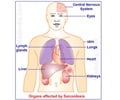
‘Cytomegalovirus (CMV) can be prevented by taking simple but intentional precautions like washing hands and cleansing of surfaces or objects that have come into contact with infected body fluids.’
Tweet it Now
CMV is the leading viral cause of childhood disabilitiesCongenital CMV (cCMV) infections cause more children to have permanent disabilities than Down Syndrome, Fetal Alcohol Syndrome, Spina Bifida, and pediatric HIV/AIDS combined. In the US, approximately 40,000 newborns are diagnosed with cCMV annually, of which an estimated 400 cases result in death, and of which 8,000-10,000 children acquire permanent disabilities, including microcephaly (the neurological impairment also caused by the Zika virus), cerebral palsy, and hearing and/or vision loss.
CMV is commonly spread by healthy children in homes, daycares, schools, and pediatric health care centers through bodily fluids, such as saliva. The virus can, which can live on a surface for up to 6 hours long enough to pose a risk for transmission to another person.
Pediatric therapists, who are predominantly women of childbearing age, have regular close contact with young children, and are thus likely at elevated occupational risk of contracting CMV.
The risk of infection during pregnancy can be significantly decreased using simple but intentional precautions, such as thorough hand washing and cleansing of surfaces and objects that have come into contact with infected body fluids.
Advertisement
The new study, led by Kathleen M. Muldoon, Ph.D., Associate Professor of Anatomy, Midwestern University, is the first to quantify cCMV knowledge in physical and occupational therapists, who commonly work with children, and who are at increased risk of contracting CMV.
Advertisement
In the current study, fewer therapists reported awareness of cCMV than other, less prevalent conditions, such as Down Syndrome, Fetal Alcohol Syndrome, or HIV/AIDS. Only 52% of participants reported awareness of cCMV. This is greater than levels of CMV awareness reported for the general population, which vary between 9%-14%, but consistent with previous reports of awareness levels amongst women who work in health care. However, only 18% demonstrated a deeper and necessary understanding of CMV by identifying ways by which the virus is transmitted from person to person.
The gap between respondents' perception of their cCMV awareness and their demonstrated understanding of CMV transmission is cause for immediate concern, as their lack of knowledge is a potential source for contracting the virus themselves, and of spreading the virus to other families. It is crucial to address this knowledge gap through educational initiatives.
Guidelines for good hygienic practices to reduce the risk of CMV infection should be a standard part of training protocols.
Behavioral precautions to prevent CMV infection include the following when therapists are interacting with young children: (1) assume ALL children are secreting CMV in their saliva, urine, and tears; (2) wash hands thoroughly with soap and warm water after activities such as feeding a child, wiping a child's runny nose or drool, or handling children's toys; (3) avoid sharing cups, plates, utensils, toothbrushes or food; (4) clean toys, countertops, and other surfaces that have come into contact with saliva, urine, or tears.
Furthermore, children who are actively shedding CMV in their bodily fluids are indistinguishable from those who are not. Therefore, reassignment of therapists into perceived lower risk areas is unlikely to be an effective protection measure, and may create a false sense of security that reassigned providers are lowering their risk of contraction.
Pediatric therapists should be advised to assume that ALL children under the age of three have CMV in their urine, saliva, and tears, and practice hygienic precautions.
Source-Eurekalert










